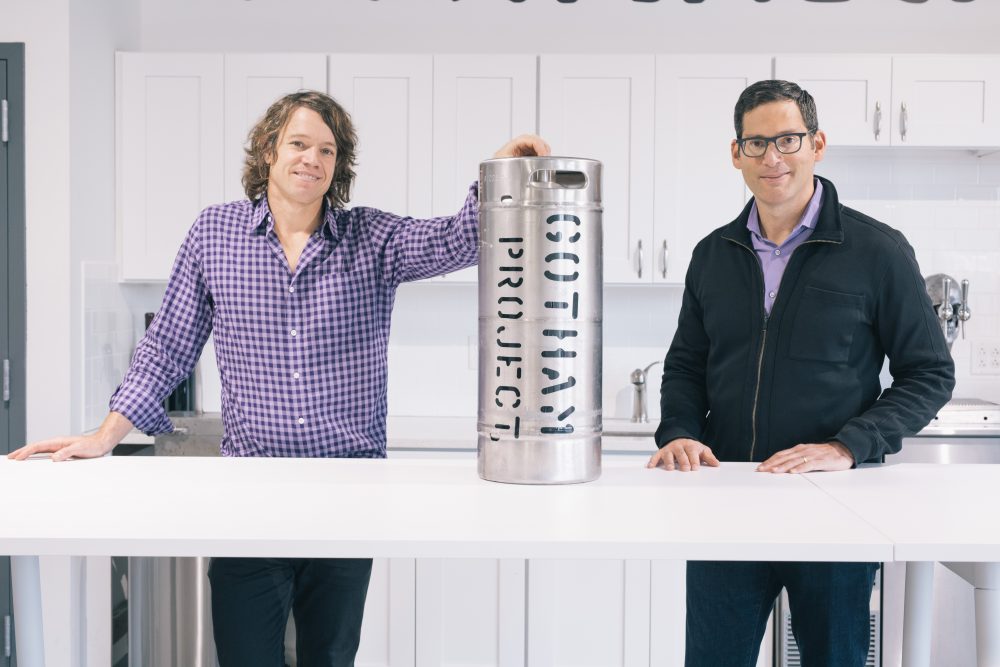In the middle of a freezing Northeast winter, thoughts of paradise beckon. Imagine a fruit-filled drink in hand as you sway in a hammock, as the ocean waves quietly crash next to you. In the early 1930s an enterprising young man thought maybe he wasn’t the only one longing to transport himself to the beach, and he decided to bring the South Pacific to the United States.
Ernest Beaumont Gannt opened Don’s Beachcomber in 1933 and filled it with straw awnings, bright colors, fruit-filled drinks and even ukulele music. His delicious concoctions became famous and Tiki cocktail culture was born. This idea only grew and soon Tiki bars were found all over America reaching their most popular heights in the ‘50s and ‘60s. Tiki bars became lavish, stylized versions of what the proprietor thought the South Pacific would feel, look and taste like. Some drinks somewhat resembled cocktails made in the islands while others were completely made up by savvy bartenders.
Tiki isn’t the only drink that can truly transport us though, and there are some cocktails that come to mind that are so widely consumed by one state or country that one cannot think of that place without conjuring an image of that specific drink.
ARGENTINA
Many classics are comprised of just two things that truly belong together, like peanut butter and jam or ham and cheese – or, in Argentina’s case, fernet and cola. Fernet and Coke – or Fernet con Coca – is almost the only cocktail consumed in Argentina. Fernet Branca is an Italian amaro that has long been popular in Argentina, served traditionally after dinner as a digestif or with a few dashes in a morning espresso. But in the early ’90s, a shrewd marketing campaign featuring the beloved Fernet Branca with Coca-Cola created a sensation. Argentina now consumes 3 times as much Fernet than its origin country of Italy. Plus, Argentina boasts housing the only production of Fernet Branca outside of Italy. At Skurnik, we make our Fernet con Coca with equal parts Contratto Fernet and Coca-Cola from Mexico for its use of natural sugars, serve in a highball and drink ice cold. Salud!
Fernet con Coca
- 2 oz Contratto Fernet
- 2 to 3 oz Coca-Cola (Mexican is best!)
Serve over ice in a highball, without garnish.
MARTINIQUE
Lime and sugar are another one of those happy pairs and is the foundation of so many drinks. The simplest cocktail is the Ti’ Punch or Petit Ponch – literally, a small punch. In the French West Indies, they drink only French-style rhum agricole. Made from fresh sugar cane juice, rhum agricole typically clocks in at about 110 proof or 55% alcohol by volume.
For a Ti’ Punch, add a little sugar cane syrup and half a lime cut into quarters then swizzle. (This is a lighter version of muddling that opens the lime juice and oils in the skin more slightly.) Enjoy at room or “air” temperature – which in Haiti, Martinique and Guadeloupe can be quite hot! Santé!
Ti’ Punch
- ¼ to ½ oz Rhum JM Sirop
- 2 oz Rhum JM 100 proof
- ½ of one lime, cut into quarters
Build in a rocks glass and swizzle ingredients.
BRAZIL
A drink almost identical to the Ti’ Punch is a Caipirinha from Brazil. Brazil makes cachaça, their version of distilled sugar cane juice. Due to terroir and use of pot stills cachaça is not exactly like rhum agricole, but similar and lives under the larger “rum” umbrella. The Brazilians have decided to fully muddle the limes, use a fine granulated sugar instead of syrup and even add a little ice. The word caipira refers to someone from the rural countryside, and inha is small. The drink can be made individually or in a larger vessel for parties. Saúde!
Caipirinha
- 2 oz of cachaça
- ½ oz of sugar or two sugar cubes
- ½ of one lime, cut into quarters
Add lime quarters and sugar in a rocks glass and muddle; add ice and top with cachaça.
MEXICO
A little farther north, rhum and cachaça are replaced with tequila, limes are juiced rather than muddled, and a little salt is added – the margarita! While there is much debate over the true origin of the margarita, there is no doubt it now associated with Mexico and the entire American Southwest. Margarita translates to “daisy,” which is a classic sour made with brandy. A margarita is more or less a classic sour, but you can add orange liqueur, or make with agave syrup for what’s known as a “Tommy’s Margarita.” Our favorite is with a splash of Giffard triple sec, simple syrup and Azteca Azul Plata. Salud!
Margarita
- 1 ¾ oz Azteca Azul tequila
- ¼ oz Giffard Curaçao triple sec
- ½ oz simple syrup
- 1 oz fresh lime juice
Shake ingredients and pour over ice in a rocks glass with a salted rim.
CUBA
Cuba is credited with many drinks, but the two that really come to mind are a daiquiri and the mojito. Like the Brazilian caipirinha and the Ti’ Punch of Martinique, the daiquiri is another classic combination of rum, lime, and sugar. The mojito also combines lime, sugar and rum, but the twist here is the addition of fresh mint creating a truly refreshing and herbaceous drink. An urban legend credits Ernest Hemingway’s mispronunciation of the word manojito – referencing a mint sprig – as mojito, thus naming the now infamous drink. Many bars in Cuba will even blend this drink with ice creating a delicious frappé. Salud!
Frozen Mojito
- 2 oz El Dorado 3 Year Old rum
- ¾ oz simple syrup
- ¾ oz lime juice
- A handful of mint leaves
Throw everything into a blender with ½ cup of ice, blend and serve overflowing from a martini or coupe glass.
Mojito (non-frozen)
- 2 oz El Dorado 3 Year Old rum
- ¾ oz simple syrup
- ¾ oz lime juice
- A handful of mint leaves
Build in highball glass: muddle mint in the bottom of the glass, add remaining ingredients, fill with ice and top with soda. Garnish with opulent sprig of mint.
JAPAN
Increasingly known for world-class whiskies, Japan also produces delicious shochu. Shochu is a distilled spirit made from either one or a combination of rice, sweet potato or barley. Like whisky, shochu is delicious in a highball format also known as a chuhai. Chuhai can be as straightforward as shochu and soda water, or a variety of sweeteners and/or citrus can be added. Salty plum, cherry blossom and other sodas are popular. A chuhai is perfect for after work or a long side an izakaya meal. Kanpai!
Chuhai
- 2 oz Mizu Lemongrass (Munemasa Brewery)
- Squeeze of lemon wedge
- 1 barspoon of simple syrup
- top with soda water
Build in a highball glass over ice, and garnish with a lemon wheel.
ITALY
Now one of Italy’s most famous drinks, the spritz was originally established in Northern Italy in a region once owned and occupied by Hungary-Austria. From the 1800s through today, German speakers of the area enjoy a spritz – or a splash of soda – in their white wine. In Venice in the 1930s, Italian bitters were added and the spritz now evolved to a true cocktail following a 3-2-1 format: three parts sparkling wine, two parts bitter orange aperitivo, and one part soda. Salute!
Spritz
- 2 oz Caffo Mezzodi l’Aperitivo
- 3 oz Prosecco della Contessa
- 1 oz soda water
Build in a wine glass over ice and garnish with an orange wedge.
SPAIN
The gin and tonic: while this drink truly belongs to the British Navy, Spain has perfected this simple highball. There a few reasons the Spanish version is superior: real tonic water or naturally flavored and sweetened tonics, large ice cubes, unique garnishes, ratio of gin to tonic (more tonic than gin) and large goblet-shaped glasses. Large open glasses allow the aromas to waft straight to your nose; this is also a reason to add unique garnishes like pepper, mint, rosemary, grapefruit, juniper, etc. Proportions should come close to three parts tonic to one part gin. Salud!
Gin y Tonica
- 2 oz Reisetbauer Blue Gin
- 5 oz Fever Tree Tonic
Build in a wine glass over ice and match ingredients seasonally, we chose pink grapefruit and a sprig of rosemary.
UNITED STATES – KENTUCKY
The Mint Julep is the official drink of the Kentucky Derby and is named from an Arabic word julab, meaning “sweet rosewater.” The mint julep is traditionally served in an iconic pewter or silver cup to create a frost on the outside that keeps the crushed ice and liquid inside cold, which means the cup must be held either by the rim or by the wider foot at the base. Though believed to have originally been made with rum not bourbon, thousands of bourbon mint juleps are now consumed at every horse race in America. Start with muddling sugar and a handful of fresh mint leaves in the base of the silver julep cup, top with 2 to 3 ounces of bourbon and add cracked or crushed ice, and then garnish with even more mint for an aromatic bouquet. Cheers!
Mint Julep
- 2 oz Medley Bros. Bourbon
- ½ oz simple syrup or two sugar cubes
- A handful of mint leaves
Build in a julep cup, top with crushed or cracked ice, and garnish with opulent mint flourish.
UNITED STATES – THE MIDWEST
The most complicated, but still iconic, beverage wraps up our tour and is coming from our very own Midwest: the brandy old fashioned. The Midwest’s brandy old fashioned is a little bit of a head-scratcher; the only resemblance to a traditional old fashioned is the glass, a sugar cube and bitters.
A traditional old fashioned is a few dashes of Angostura bitters, a sugar cube, and two ounces of whiskey that are stirred with a large ice cube and garnished with an orange twist. A brandy old fashioned, on the other hand, is made with brandy for one, a sugar cube covered in bitters, a brandied cherry and an orange slice, which are all muddled together with great care, carefully crushing the cube and squishing the cherry to oblivion while the orange wedge is only lightly muddled to avoid the pith and bitter rind making way into the cocktail. Ice is then added, as well as the mandatory two ounces of brandy (American, of course, if you have it.) The final touch is “sweet”: a splash of Sprite or “sour” (meaning Squirt) – or “press,” which is a little of both. It is believed that the addition of fruit and juice (Sprite and/or Squirt) started during Prohibition to create more palatable libations when people had to consume poorly produced-bathtub style spirits. The Midwest has held strong to this tradition born in the 1920s. Cheers!
Brandy Old Fashioned
- 2 oz Dudognon Selection Cognac
- 1 cube of sugar
- 1 brandied cherry
- 1 orange wedge
- 3 dashes of angostura bitters
- Top with Sprite (and/or Squirt)
Place the sugar cube in a rocks glass, dash 3 splashes Angostura bitters directly on the cube, add brandied cherry and orange slice and muddle. Add ice and brandy, top with Sprite (and/or Squirt) and garnish with an orange wheel and another brandied cherry.
Rife with history and flavor, these iconic cocktails can truly transport us to a beach in Mexico, a Milonga in Buenos Aires, or a bar in Wisconsin in the 1920s. If comfort food existed in drinks form, it would be probably taste like any and all of these easy-drinking cocktails.





